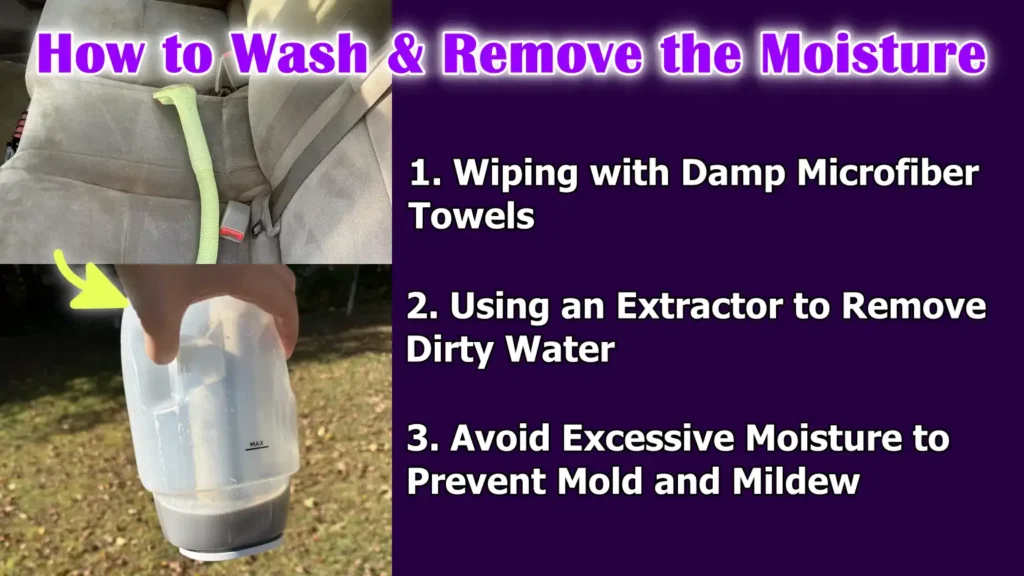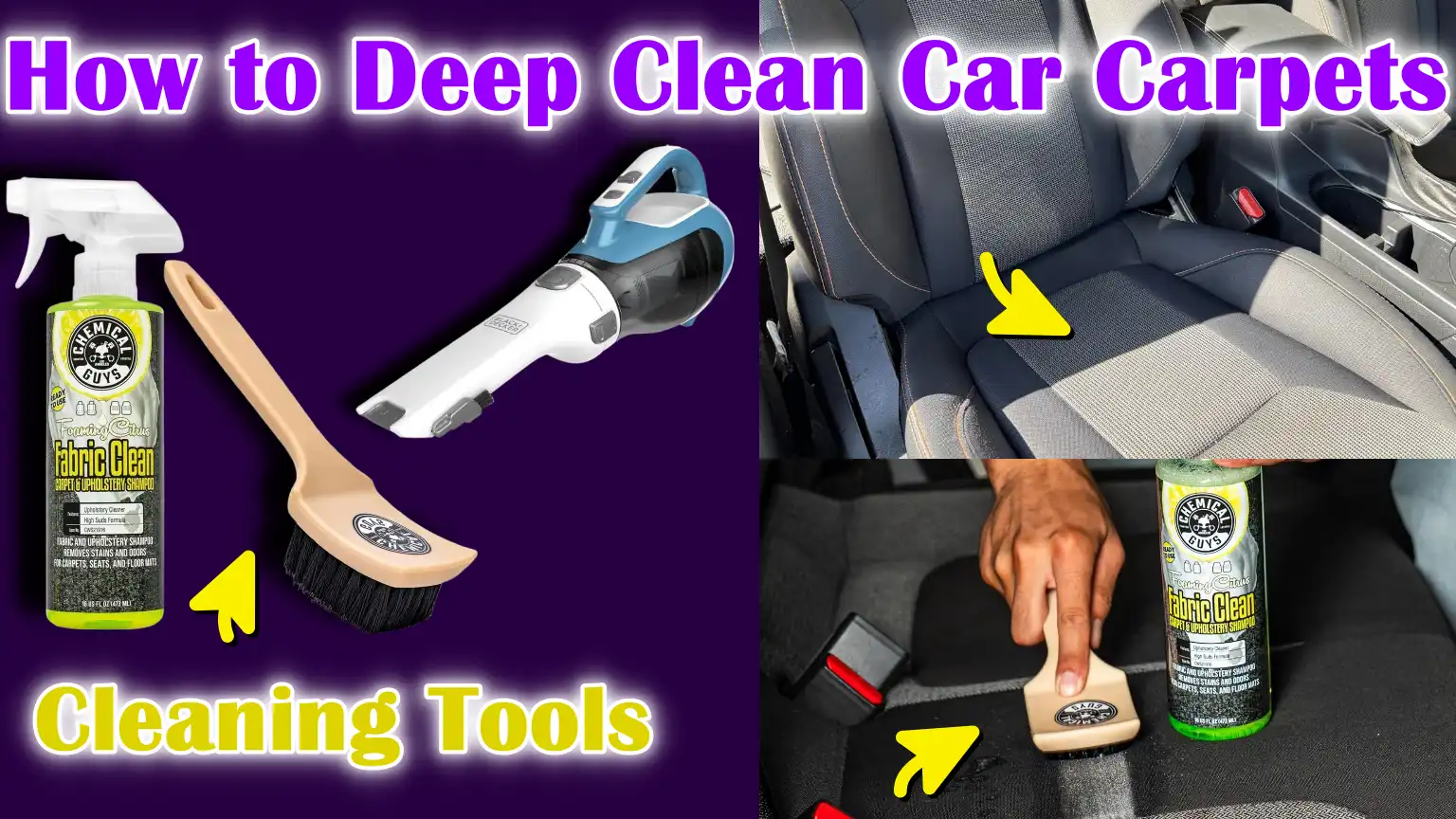Written By: Don Dodi
Fact Checked By: Kristen Brown
Reviewed By: Diego Rosenberg
It is the fact that car carpets actually holds lots of hidden dirt, germs and bacteria, as carpet is just like the sponge: and that’s why it traps mud, crumbs, dust and even it mess up the smooth odor inside the vehicle.
As well as, studies on vehicle hygiene also shows that the average car interior can be up to 17,000 times dirtier than a household toilet seat, which is literally eye popping and carpets are one of the main culprits as they traps food crumbs, mud, hair and pollen as well.
As even when you regularly vacuuming it also doesn’t removes deep down dirt and stains as it just removes surface debris only and that’s why it affects the car’s air quality and even it can create unpleasant odors.
Basically you’ll need to give it deep cleaning to restore the carpet’s appearance and it also extends its life, prevents mold growth from moisture and that makes the driving experience more healthier and really comfortable atmosphere.
Now, this is the guide about How to Deep Clean Car Carpets, just maintain your carpet’s cleanliness and maintain your car’s value as well.
How to Do Preparation Before Cleaning
1. Gathering Necessary Supplies
Before you begin deep cleaning your car’s carpets, it’s important to have all the necessary supplies ready.
This ensures an efficient and smooth process and avoids interruptions.
Essential tools include a powerful vacuum cleaner for removing loose dirt, a carpet cleaner for removing stubborn grime, a stiff brush for agitating and lifting dirt, microfiber towels for wiping and drying and a spray bottle if you plan to use a homemade cleaning solution.
Having everything ready in advance not only saves effort but also prevents stains and ensures a more even and effective cleaning.
Using the right tools is specially important, as the wrong tools can damage carpet fibers or leave residue that attracts more dirt.
2. Removing Floor Mats and Personal Belongings
Before cleaning the carpets, it’s essential to remove all floor mats and personal belongings from the car’s interior.
Floor mats often accumulate heavy dirt, mud and liquid stains that can transfer to the carpet if left unattended during cleaning.
Similarly, bags, tools and other objects can obstruct access to corners, under seats and edges where dirt and dust accumulate.
Cleaning the car interior ensures that every area of the carpet is thoroughly cleaned without interruption and prevents accidental damage to personal items during the process.
3. Shaking and Pre-Cleaning Floor Mats Separately
After removing floor mats, it’s important to shake them out and pre-clean them separately.
Rubber or all-weather mats can often be rinsed with water and wiped with a cloth, while fabric mats benefit from a quick vacuuming or pre-cleaning with a carpet cleaner.
Pre-cleaning the mats reduces the overall dirt load before working on the main carpet, preventing dirt from spreading back to freshly cleaned areas.
This step provides targeted cleaning of even heavily soiled mats and ensures that the entire car interior is clean and free of dirt.
How to Vacuum Carpets Thoroughly
1. Using a Powerful Vacuum Cleaner with Attachments
Thorough vacuuming is one of the most important steps in deep cleaning car carpets.
Using a powerful vacuum cleaner with special attachments allows you to reach all the dirt and debris deeply embedded in the carpet fibers.
Normal vacuuming often only removes surface dust, but a powerful vacuum cleaner can remove fine particles like sand, dust mites and small particles that accumulate over time.
Attachments like narrow nozzles and brush heads help reach tight spaces, edges and corners where dirt hides.
Using the right vacuum cleaner ensures that the carpets are ready for deep cleaning and prevents stubborn dirt from becoming more ingrained during the cleaning process.
2. Moving the Seats
To reach all areas of the car carpet, it’s important to move the seats back and forth.
Dirt and debris often accumulate under the seats and near the seat rails, areas that can easily be overlooked without adjusting the seat position.
Sliding the seats allows you to clean underneath, ensuring that even hidden areas that rarely see light are cleaned.
Neglecting these areas can cause dust and allergens to accumulate in the carpet, leading to unpleasant odors and poor indoor air quality.
3. Attention to Dust-Prone Areas
Some areas of the car’s carpet accumulate more dirt than others and require more attention.
The driver’s side, specially under the pedals, often accumulates dirt, grease and grime from daily use.
Similarly, areas around the seat rails and footwells also accumulate debris that gets embedded in the carpet fibers.
Spending more time on these dust-prone areas ensures that the deep cleaning process is effective, keeping the car’s interior clean, fresh and attractive to look at.
Regular attention to these areas also helps prevent long-term damage to the carpet caused by accumulated dirt and dust.
What are The Pre-Treatment of Stain
1. Identifying Common Stains
Before deep cleaning your car’s carpets, it’s important to identify the type of stain.
Car carpets often become stained by coffee spills, mud, grease, soda, food particles and even oil or dirt from shoes.
Each type of stain has its own unique characteristics and may require a slightly different approach to remove effectively.
Identifying the type of stain ensures you use the correct cleaning method, which increases the chances of completely removing the stain without damaging the carpet fibers.
Ignoring specific types of stains or using the wrong cleaning solution can cause permanent stains and shorten the carpet’s lifespan.
2. Appropriate Stain Removers or Do-It-Yourself Solutions
Once the stains have been identified, the next step is to apply the appropriate stain remover.
Commercial carpet cleaners designed for use in cars are effective at removing grease, coffee and other common stains.
For those who prefer do-it-yourself solutions, household ingredients like baking soda, white vinegar, or mild dish soap can also be very effective.
Baking soda works to lift dirt and absorb odors, while vinegar helps remove organic stains and neutralize odors.
It’s important to apply the solution evenly to the stained area so it penetrates the carpet fibers without oversaturating, which could cause mold or damage.
3. Pre-treating Before Scrubbing
After applying the cleaning solution, it’s important to let it sit for a few minutes before rinsing.
This waiting period allows the solution to effectively break down the stain particles and separate them from the fibers.
Gently scrubbing with a soft or hard brush afterward helps remove the dirt without damaging the carpet.
Rushing the process or skipping the waiting period may result in the stain not being completely removed and may require repeated cleaning, which can be detrimental to the carpet over time.
Proper pre-treatment ensures that deep cleaning is more effective, leaving the car interior fresh, clean and healthy.
How to Do Deep Cleaning Carpets
1. Applying the Carpet Cleaner Evenly
The first step in deep cleaning car carpets is to apply the carpet cleaner or diluted cleaning solution evenly to the surface.
This even application ensures that every part of the carpet receives proper treatment, preventing uneven cleaning or missed spots.
Specialized automotive carpet cleaners are designed to remove stuck-on dirt, grease and oil without damaging the fibers.
For those using a household solution, a mixture of mild dish soap and water or a vinegar and water solution can also be effective.
Evenly applying the cleaner helps it reach deep into the carpet, loosening stuck-on dirt and preparing it for the next step.
2. Scrubbing with a Stiff Brush
After applying the cleaning solution, scrubbing in a circular motion with a stiff brush removes dirt, grime and stubborn particles from the carpet fibers.
The circular motion ensures that the fibers are evenly agitated, helping to remove deeply embedded dirt.
To maximize the cleaning effect and avoid damaging the carpet, scrub gently but firmly.
Regular brushes or car-specific scrubbing tools work best, as they are designed to handle automotive carpet fibers without abrasion.
Proper scrubbing not only improves cleaning but also restores the carpet’s texture and appearance.
3. Using a Steam Cleaner or Carpet Extractor
For an even deeper cleaning, using a steam cleaner or carpet extractor can be highly effective, although this is optional.
Steam cleaning uses hot water and steam to remove stubborn dirt and kill bacteria, while carpet extractors spray a cleaning solution and simultaneously remove dirt and moisture with a vacuum cleaner.
This method reaches the deepest layers of the carpet that manual scrubbing can miss, eliminating allergens, bacteria and lingering odors.
Although not completely necessary for every car, a steam cleaner or extractor is highly recommended for vehicles with heavy soiling or long-neglected carpets, as it provides a professional-grade cleaning and ensures a healthy interior environment.
How to Wash & Remove the Moisture

1. Wiping with Damp Microfiber Towels
After deep cleaning carpets, it’s important to remove excess cleaning solution and dirt.
Using damp microfiber towels is extremely effective because their soft fibers absorb moisture and residue without damaging the carpet.
Wiping in sections ensures that the cleaner and loosened dirt are evenly removed, preventing streaks or sticky areas.
This step also reduces residual moisture in the carpet, which is essential for preventing odors and reducing drying time.
Microfiber towels are preferred because they absorb dirt efficiently and can be washed and reused multiple times, making them both effective and cost-effective.
2. Using an Extractor to Remove Dirty Water
To remove moisture more thoroughly, a carpet extractor can be used.
Extractors spray the cleaning solution while vacuuming up the dirty water and dissolved dirt.
This process removes dirt and moisture from the deepest layers of the carpet, leaving it much cleaner than hand mopping.
Using an extractor is specially helpful for cars with deep stains or carpets that haven’t been cleaned in a long time.
This removes almost all dirt and cleaning solution, leaving the interior much cleaner and fresher.
3. Avoid Excessive Moisture to Prevent Mold and Mildew
One of the most important things to remember when cleaning and removing moisture is to avoid excessive moisture.
Prolonged wet carpets can lead to mold and mildew growth, which not only causes odors but can also damage carpet fibers and degrade indoor air quality.
Removing as much water as possible using towels, an extractor, or gentle blotting methods can help prevent these problems.
Ensuring that the carpet is not overly wet is an important step in keeping the interior healthy, clean and long-lasting.
Read More:
The Drying Process
1. Ventilating the Car
After washing and removing moisture from carpets, proper ventilation is essential for thorough drying.
Opening the car doors and windows allows fresh air to circulate inside the car, which accelerates evaporation and helps prevent mold and mildew growth.
Good airflow is specially important under seats and in corners, where moisture tends to accumulate.
Adequate ventilation also helps remove residual cleaning solution odors, keeping the car interior fresh and pleasant.
2. Using a Fan or Wet/Dry Vacuum Cleaner
To speed up the drying process, additional equipment such as fans or wet/dry vacuum cleaners can be very effective.
Fans increase air circulation inside the car, accelerating moisture evaporation, while wet/dry vacuum cleaners can extract any remaining moisture from deep within the carpet fibers.
Using these equipment not only reduces drying time but also reduces the risk of mold and mildew growth.
This is specially useful in humid climates or colder months when natural evaporation is slow.
3. Ensuring Carpets Are Completely Dry
Before putting floor mats back in the car, it’s important to ensure that the carpets are completely dry.
Even slightly wet carpets can cause moisture to accumulate under the mats, creating ideal conditions for mold, mildew and odors.
Touching different areas of the carpet and checking for any hidden wet spots can ensure the drying process is complete.
Thoroughly dry carpets retain their texture, prevent health hazards and keep the car interior clean, fresh and durable.
How to Clean & Replace Floor Mats
1. Washing Floor Mats Separately
After cleaning and drying the car’s carpet, it’s important to pay attention to the floor mats, as they often accumulate the most dirt, mud and spills.
Rubber or all-weather mats can be thoroughly washed with soap and water and gently scrubbed to remove any dirt, grease and stains.
Cloth mats should first be vacuumed to remove loose debris and then cleaned to remove deeply embedded dirt and restore freshness.
Washing the mats separately makes the cleaning process more effective and prevents dirt from returning to the newly cleaned carpet.
Proper cleaning of the mats also reduces odors and maintains the overall cleanliness of the car’s interior.
2. Drying thoroughly before replacing
After cleaning, the floor mats should be thoroughly dried before returning them to the car.
Damp mats can cause water to accumulate between the mat and the carpet, creating an environment where mold, mildew and bacteria can thrive, leading to unpleasant odors and potential health problems.
Rubber mats generally dry quickly, but fabric mats may take longer to dry depending on their thickness and weather conditions.
Ensuring the mats are completely dry before replacing them protects the carpet underneath, extends the life of both the mat and carpet and keeps the car interior fresh, clean and safe for everyday use.
7. Maintenance Tips to Keep Carpets Clean Longer
Furthermore, research has shown that the car interior is a confined space where microorganisms can easily live in dust and carpet fibres, which is why regular deep cleaning actually reduces these reservoirs and reduces the chance of contaminants being released back into the air, even while driving.[¹]
1. Regular Vacuuming
One of the most effective ways to keep car carpets clean is to vacuum regularly, ideally at least once a week.
Regular vacuuming removes loose dirt, dust, food crumbs and other debris before they become deeply embedded in carpet fibers.
Studies on vehicle hygiene show that accumulated dust and dirt can breed bacteria and allergens, which can affect indoor air quality.
Regular vacuuming not only maintains the beauty of carpets but also extends their lifespan and makes future deep cleanings easier and more effective.
2. Use Floor Mats for Protection
Floor mats are an essential means of protection from heavy dirt, mud and spills.
By using rubber, all-weather, or fabric mats, you prevent damage to the carpet underneath and reduce the need for cleaning.
Mats are easy to clean and can be removed, washed and dried separately, preventing dirt and moisture from settling into the main carpet.
Proper use of mats significantly reduces carpet wear, maintains its texture and helps keep interiors clean and hygienic.
3. Immediate Remedies for Spills
To avoid permanent stains and lingering odors, it’s important to act immediately upon a stain.
Liquids such as coffee, soda, or water, which contain dirt, can quickly become embedded in carpet fibers if left untreated.
Immediate wiping with a clean cloth or towel, followed by an appropriate cleaning solution, helps remove stains before they set in.
This method reduces the need for frequent cleaning, preserves the carpet’s texture and prevents stains from becoming permanent or fading.
4. Using Fabric Protectants
Applying fabric or carpet protectants is an effective preventative measure to keep carpets clean for a long time.
These products create a thin, invisible film over carpet fibers that repels liquids, dirt and stains, making subsequent cleaning much easier.
Protectants can maintain the carpet’s softness and texture, as well as extend its lifespan.
Regular use of protectants, along with proper cleaning practices, ensures that your car’s carpets remain fresh, clean and attractive for years to come.
Conclusion- How to Deep Clean Car Carpets
You should not neglect the importance of clean carpets, as there can be hidden dirt, bacteria and all kinds of unpleasant odors available and that can literally responsible to affect your comfort and health as well.
Carpets act as natural filters, trapping dirt, dust, allergens and bacteria, which can accumulate over time and negatively impact air quality.
By following systematic methods like preparation, vacuuming, pre-treating stains, deep cleaning, washing, drying and proper floor mat care, you not only remove visible dirt but also prevent long-term damage, mold and unpleasant odors.
Regular maintenance, such as regular vacuuming and the use of protective mats or fabric protectants, ensures your carpets remain clean, fresh and long-lasting.
Caring for and maintaining your car’s carpets in a timely manner increases your vehicle’s overall cleanliness, comfort and resale value, as well as creating a more pleasant driving environment for you and your passengers.
Ultimately, clean carpets reflect a clean, well-cared-for vehicle and every car owner should strive to achieve this.
Now, that’s it from this guide and you can ask related questions in the comment box.
Frequently Asked Questions
Q1. How often should I deep clean my car carpets?
Answer: Car carpets should be deep cleaned at least once or twice a year, depending on usage. If you drive frequently, have children or pets, or live in a dusty area, deep cleaning may be necessary every three to six months. Regular vacuuming between deep cleanings is essential to prevent dirt from becoming embedded in the fibers. Regular maintenance prevents odors, mildew and permanent stains, keeping carpets looking fresh and increasing their durability.
Q2. Can I use household products to clean car carpets?
Answer: Yes, household products can be effective for cleaning car carpets. For example, baking soda is excellent for absorbing odors and loosening dirt, while vinegar can help remove stains and neutralize odors. Mild dish soap mixed with water can also be used as a gentle cleaning solution. To avoid mold or damage, these solutions should be used with caution, avoiding over-saturation. While household products are good for light to medium cleaning, professional carpet cleaners or extractors are recommended for heavily soiled carpets or stubborn stains.
Q3. How to Remove Stubborn Stains from Car Carpets?
Answer: To remove stubborn stains, first identify the type of stain, such as coffee, grease, mud, or soda. Apply an appropriate pre-treatment solution and leave it for a few minutes to penetrate the fibers and loosen the stain. Gently scrub in circular motions with a stiff brush to remove dirt without damaging the carpet. For deep or old stains, a steam cleaner or carpet extractor can help remove residue and kill bacteria. Acting immediately on stains prevents permanent stains and ensures a clean, fresh carpet over time.
Q4. Do car carpets need to be thoroughly dried after cleaning?
Answer: Yes, it’s important to thoroughly dry car carpets after cleaning. Moisture trapped in carpet fibers can cause mold and mildew, which can lead to unpleasant odors and damage the carpet. Thoroughly drying the carpet can be done by opening the car doors and windows, running fans, or using a wet/dry vacuum cleaner to remove any remaining moisture. Checking for hidden wet spots before replacing floor mats ensures the carpet will remain clean, fresh and safe to use.
References:
[1] Airborne Pathogens inside Automobiles for Domestic Use: Assessing In-Car Air Decontamination Devices Using Staphylococcus aureus as the Challenge Bacterium
https://pmc.ncbi.nlm.nih.gov/articles/PMC5411498/

Guys, I’m a car audio enthusiast and customization expert and I love clear sound and clean installation. Plus, I have spent years helping people build their dream audio setups. And whenever I’m working on cars, I probably listen to music and thinks about the next big upgrade.

